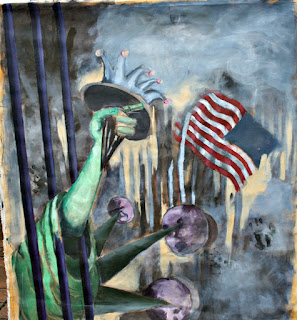Regards sur le Sommeil by Veronique Dalmasso - 23rd November 2016
On Wednesday evening, I attended a talk given by a visiting French lecturer, Veronique Dalmasso, based on her recently published book, Regards sur le Sommeil, written in collaboration with Stephanie Jamet-Chavigny.
Ms Dalmasso outlined the background to her research on this work, which explores the representation of sleep in Western Art, from the Renaissance period to modern day. Works of art from distant eras are presented alongside contemporary pieces in diptych format, which provides an interesting juxtaposition of concepts and styles. 'For instance Bellini's Drunkeness of Noah [1515] is printed alongside Francis Alys' Sleepers 11 [1999/01]. Two works with different ambitions on behalf of the artist but when seen together, initiate an interesting conversation. I was somewhat disappointed to
discover that this lecture was not based on a discussion of the importance and relevance of dreams in art generally but it was, nonetheless, an intriguing topic.
The Use of Stencil in Painting by Dulce Osinski, assisted by Iriana Vezanni - 24th and 25th November 2016.
This was a series of two three hour workshops organised by The Academy of Fine Art in Zagreb in conjunction with the Fine Art Department of the University of Parana in Brazil where Dulce is a lecturer in the History of Art. She began the workshop by discussing the techniques of artists who used stencils in their work - Piet Mondrian, Matisse, Roy Lichenstein, Sigmar Polke and introduced us to her work and that of other Brazilian artists, Paolo Sister, Alex Fleming and Adriana Tagalipa.


 We were then asked to create our own stencils
We were then asked to create our own stencilsusing x-rays provided by Professor Turcic, possibly attained from her personal collection!
I chose to create the word FEAR and it was
a steep learning curve to cut this out without losing the interior of the letters. It was my response to the recent catastrophic outcome of the US presidential election. [In my opinion, of course, not everyone would agree!] I also cut out images of stars, a reference to the American flag. We used acrylics, foam rollers and paintbrushes to work with the stencils. I worked with just three colours, blue, red and white. I didn't get this work finished but I will return to it later on and will use the stencil and its negative format in future paintings.
For the second workshop on Friday morning, I wanted to explore the theme of presence/absence and drafted a stencil of a hand and coffee cup and circle. I wanted to curtail my palette but was also interested in creating neutral colours, so the work below evolved. Orange, pink, dark blue. It was kind of freaky working with these images of someone's interior body parts and I feel I should explore more of this type of work but using the actual imagery in the x-rays. This reminds me somewhat of my work with cyanotype a few years ago. A good session with plenty of food for thought for incorporating these stencils in other work, not just painting but with drawing and illustrations. It was lovely to work with Dulce and Iriana and their work is really unusual. Back in my studio, I worked on the palette of left over acrylic paint and some interesting imagery evolved from it.




































